
Affordable. Accessible. Local.
Building the future of Arts and Culture in South Charlotte
Charlotte Center for the Arts is working to create spaces in South Charlotte that unite performance, visual arts, and education under one roof. These dynamic new spaces will serve as a vibrant community hub and cultural destination for the region.
What
We envision building a brand new space with...
-
Stages available for rent by organizations and individuals for the presentation of performances, recitals, lectures, conferences, and film showings
-
Resident performance companies
-
Collaboration with local school programs
-
Auxiliary location opportunities for existing visual and performing arts organizations
-
Makerspace
-
Experimental technology and workshop space
-
Classroom space for visual and performing arts classes
-
Cultural and arts festivals
-
Event Space for formal events, weddings, conferences, and meetings
-
Rotating visual arts exhibition space
-
Apprenticeships in technical theatre skills
-
Pre-professional and professional training programs
-
Outdoor Arts Playground
-
Free, live outdoor events to engage the community
-
State-of-the-art facilities with live-stream opportunities for performances and galleries
A landmark exterior to engage the community and become a destination
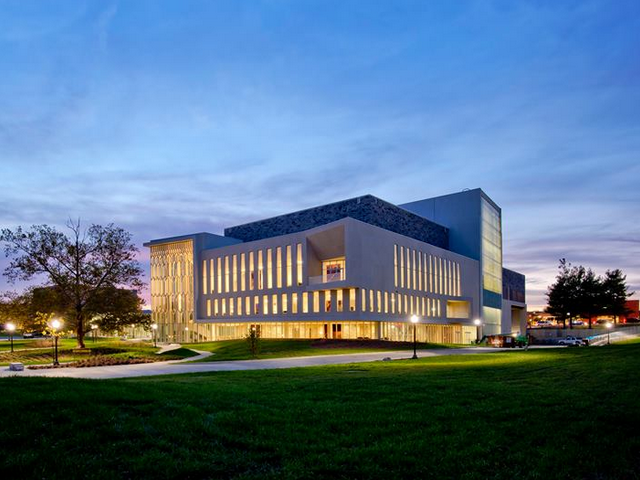
Blacksburg, VA
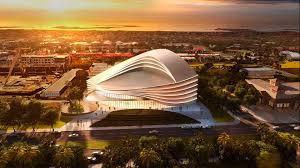
Naples, FL

Attica, Greece

Blacksburg, VA
-
A modern, adaptive architectural design
-
Interior atrium that is inviting from the outside
-
Outdoor performance area and lawn for festivals and community use
-
A signature architectural look that is recognizable from even outside the Charlotte metro area
Multi-functional indoor space to serve the community and attract talent to Charlotte
-
~100,000 SF facility
-
Multiple performance spaces
-
1000 seat proscenium with state-of-the art technical theatre elements
-
250-400 seat flexible black box
-
-
Full-size rehearsal space
-
Lobby with event potential
-
Visual arts exhibit space
-
Classroom studios
-
Professional meeting space & offices

(Austin ISD Performing Arts Center, Austin, TX)

(Peabody Essex Museum, Salem, MA)
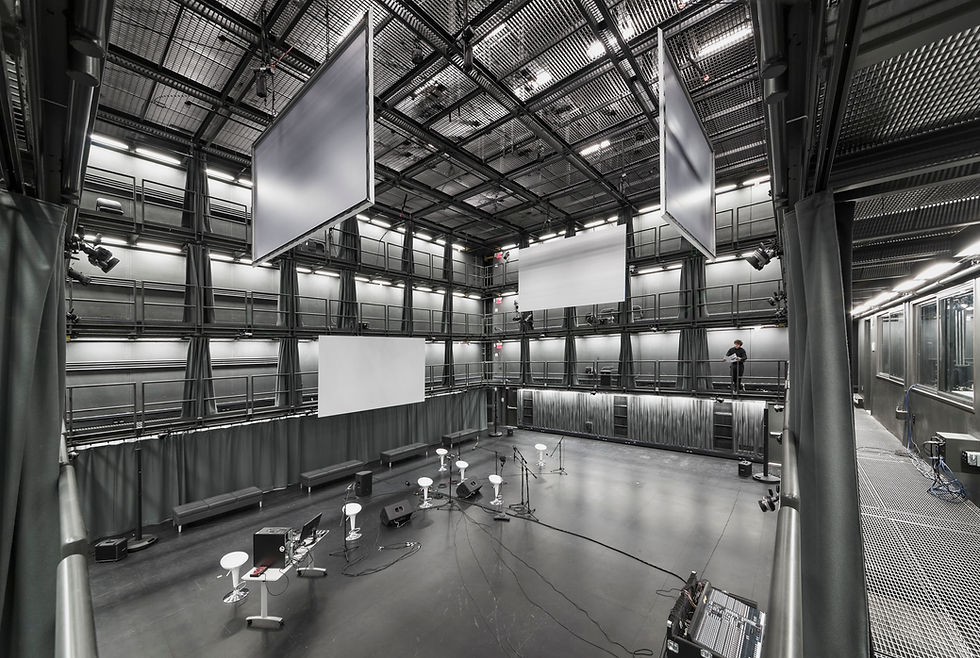
(Moss Center for the Arts at Virginia Tech, Blacksburg, VA)

(Austin ISD Performing Arts Center, Austin, TX)
*Note: All functions and spaces described on this page are programming possibilities in the Charlotte Center for the Arts space, and are not a guarantee of programs and spaces to be offered. See "When" section below for more information on the pre-design programming process.
Charlotte Center for the Arts would serve as an Arts and Culture hub with rehearsal spaces and classrooms that complement the performing spaces and galleries inside the building, all flowing into an exterior space that would invite in all members of the community--this is an amenity that South Charlotte is long overdue to have.
Why
Arts infrastructure has not kept pace with the rapid growth of Charlotte
The greater Charlotte Metro area has experienced unbelievable growth during the course of the past 10-20 years. Charlotte was also ranked #3 on US News and World Report's 25 Best Places to Live in the U.S. in 2024-2025 list, as it checks a lot of the "boxes" for people looking to put down roots. As our city has become a vibrant hub of activity for banking, business, sports, food, shopping, and so much more, our local Arts communities have struggled to keep pace.
One of the biggest challenges shared by all of the local Arts is a lack of access to space. Despite continued investments in expanding the infrastructure of Charlotte outward from Uptown, we see fewer and fewer spaces available--gallery space for visual artists to display their work, stages for performing artists to showcase their talents, cultural gathering spaces to demonstrate the depth of what our City has to offer.
Charlotte is no longer present in the Charlotte Arts Scene
Even before COVID, the once vibrant local arts scene of Charlotte was experiencing a slow decline. There are only a few organizations left that support and promote local artists from the Greater Charlotte area, which is a small number of organizations compared to other cities of comparable size. Staples in the community, like the Actor’s Theatre of Charlotte, suffered and ultimately had to shut their doors due to lack of available space, lack of affordable space, lack of support from local/City government, and lack of funding/ability to generate income--all issues which Charlotte Center for the Arts focuses on as the basis of their mission.
Furthermore,
-
Charlotte is increasingly reliant on “out-of-town”, or national, talent to draw audiences, limiting professional opportunities for local and regional artists
-
Local artists are continuing to leave Charlotte to seek more and more professional opportunities.
-
There is limited inventory of performance spaces, all of which are either too expensive, difficult to book, or too small
-
Most college theatres give preference to school/donor-based events, and only schedule a year in advance
-
Inaccessible: Many theatres are only available to resident theater companies
The City recognizes the need for Arts and Culture facilities like what Charlotte Center for the Arts plans to build
The City of Charlotte recognizes many of these needs in their Arts and Culture Plan, which was accepted in November 2023, the priorities of which align with Charlotte Center for the Arts' mission:
-
Ensure Sustainable and reliable funding for arts and culture
-
Work across the public and private sector to build a sustainable future for the arts
-
Provide Equity, Accessibility, and Inclusion for all artists within our community
-
Eliminate barriers to creation and participation in the arts
-
Raise awareness
-
Foster Collaboration
-
Expand arts education
In conjunction with the needs expressed by the greater Charlotte community, along with the compelling feedback we have personally received over the last few years from arts organizations and visual artists, we are proposing a plan to engage developers, the City, and artists like you to come together and build a new Center for the Arts in South Charlotte.
Where
A Space in South Charlotte…to serve ALL of Charlotte
Geographically speaking, Charlotte Center for the Arts is looking to identify development partnerships in South Charlotte (rough area can be seen on the map, below left).
This location is characterized by easy access to I-485 and being adjacent to Union County, NC and York/Lancaster Counties, SC. Charlotte Center for the Arts would be positioned in the areas of highest population density in Mecklenburg County (see map overlayed with rough development location, below right). Some areas of South Charlotte even exceed double the average county density; This is important to note in considering the magnitude of Charlotte Center for the Arts' potential audience, especially considering the proximity to nearby Boulevard corridors identified by CDOT, such as Pineville-Matthews Road, Providence Road, Ballantyne Commons Pkwy, Ardrey Kell Road, and Johnston Road, that connect more areas underserved by existing arts infrastructure.
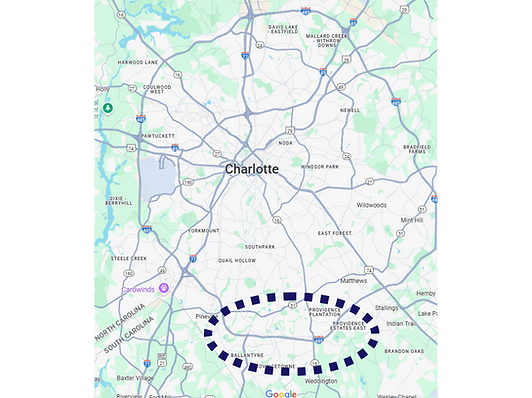.png)
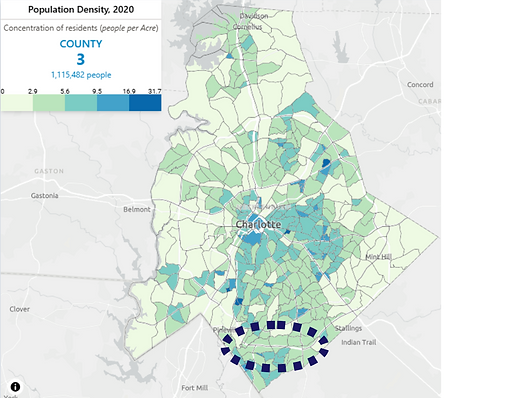.png)
Statistically speaking...

Charlotte Population Growth
-
2010 Charlotte Metro population: 1,265,000
-
2024 Charlotte Metro population: 2,900,000
-
2050 Charlotte Metro population (projected): 4,600,000
-
(Source: Charlotte Regional Building Alliance)

Access to Capital
Median household income in South Charlotte (City Council district 7) was 60% higher than the County median household income in 2021 and 65% higher than the US median household income reported by the US Census Bureau (Source: Charlotte/Mecklenburg Quality of Life Explorer)

South Charlotte Expansion
-
Mecklenburg County is the 2nd most populous county in NC with over 1.1M residents (Source: Mecklenburg County Office of Economic Development)
-
Neighboring Union County grew 23.2% between 2010 and 2022 compared to 11.7% for rest of NC (Source: USA Facts)
-
Union County, North Carolina’s fastest growing county during the 1990s, is projected to grow to just over 327,000 people by 2030, an increase of 165 percent over the same time period. (Source: Charlotte Regional Transportation Planning Organization)
The need is particularly strong in the South Charlotte area where we have seen unprecedented population growth. We at the Charlotte Center for the Arts envision a space in South Charlotte (Mecklenburg County) with performance stages and exhibit space for local and regional artists, where both the artist and the patron feel invited into the space without barriers such as: parking being easier and more affordable, ticket prices being more affordable, and the performance space being closer to where many artists and patrons live.
Ballantyne is continually drawing more and more companies to be headquartered there. As such, more and more people are wanting to focus their daily activities and entertainment choices in the immediate area in which they work and live. Charlotte Center for the Arts would be able to complement the growth that Ballantyne has rightfully anticipated and provoked in South Charlotte.
The City recognizes the need for Arts and Culture facilities in areas of Charlotte where Charlotte Center for the Arts plans to build

The Charlotte Future 2040 Community Area Plans for "South Middle" and "South Outer" specifically identify a need in South Charlotte for "Regional Activity Centers" which are "characterized by a mix of uses (residential, employment, and entertainment). Noting that this "Place Type change will add...density to the recommended areas" and "provide placemaking elements", this opens up many existing planned communities in South Charlotte to be redeveloped with an entertainment hub, such as Charlotte Center for the Arts, in mind.
These Community Area Plans include Placemaking Assessments that "should be used by decision-makers to identify future projects or improvements [and] to prioritize programmatic funds". Five of the seven Placemaking elements listed (Public Spaces, Public Play Areas, Amenities & Furnishings, Branding, and Public Art) can be improved upon with the construction of Charlotte Center for the Arts and related development. Specifically, the "Public Art" element is more often than not identified as "Not Aligned with Aspirations" in the South Charlotte area shown in the graphics above, meaning that it is a feature that is severely lacking and has negative community character implications. Furthermore, Community Character Recommendation CC-5, CC-6 and CC-8 state, respectively:
-
To celebrate neighborhood identity and strengthen the sense of place, Charlotte should support placemaking efforts such as...public art, and gateway elements at key intersections. Additionally, the city should integrate art and design into infrastructure and public spaces whenever possible.
-
To create vibrant public spaces that foster community gatherings, Charlotte should explore partnerships with private property owners to temporarily or permanently transform underutilized area, such as vacant lots or parking lots, into active public spaces. These spaces should be programmed with community-driven activities, including community gardens, parks, festivals, and pop-up events.
-
To enhance public realm amenities in mixed-use places, Charlotte should explore the creation of a fund that supports community-driven improvements that further the goals of the Charlotte Future 2040 Comprehensive Plan and Community Area Plans.
We envision Charlotte Center for the Arts to be a part of a larger community, with retail, housing, hotels, restaurants, and green space integrated into the immediate area, allowing for mutually beneficial economic impacts in the surrounding areas. We see housing as being critical for regional performers, restaurants and hotels being critical for patrons, and retail and green space critical to making this a destination for all of Charlotte, the surrounding region, and beyond.
The lack of arts infrastructure, specially a regionally-reaching arts center, is not consistent with where the population is greatest in Charlotte, as seen by the Charlotte Quality of Life Explorer Map above. Furthermore as it relates to funding, City and State Grant money is being given to arts and culture organizations, but the benefits are rarely passed along to Charlotte groups and assets outside of the Uptown Charlotte bubble ("Uptown boasts a large concentration of cultural amenities — more than 50. At the same time, many areas outside of center city currently have few arts and culture amenities, for example there are fewer than 30 physical arts and culture assets in Charlotte-Mecklenburg’s Corridors of Opportunity." City of Charlotte State of Culture Report, February 2023)
If we don't build in South Charlotte, we risk
losing involvement in Arts and Culture
The political scientist Robert Putnam Suggests that every ten minutes of commute time "cuts involvement in community affairs by 10 percent'" (Source: Putnam, Bowling Alone: The Collapse and Revival of American Community (New York: Simon and Schuster, 2001), p. 213). As commute times get longer and longer from South Charlotte to Uptown, so the South Charlotte arts patron's involvement will become less and less.
Now is the time to build a Center for the Arts in South Charlotte.
When
2025 and Beyond: Starting, Building, Growing
Building an organization at the same time as building a performing and visual arts center is not something that happens quickly. Kindling relationships with partners and donors is something that takes time. The Charlotte Center for the Arts Board of Directors has carefully plotted out a roadmap to match a campaign that will take us from the early days of raising awareness to the opening performance in our new building, and beyond.
Below is a rough outline of the phases in which we envision this project and our mission taking shape:
-
Years 1-2 (2025-2026): Starting up and raising awareness
-
Years 3-5 (2027-2029): Fundraising and partnerships
-
Years 6-7 (2030-2031): Groundbreaking and construction
-
Year 8 (2032): Ribbon cutting and first season of programming
-
Years 9-10 (2033-2034): Growing and scaling up
Our campaign page has more detailed information about each of these phases and what we plan to accomplish in each phase:
How
Removing Barriers
A new model
Most traditional models leverage a flat rental fee, regardless of the size of your organization. This is one of the biggest barriers for most artists in presenting their work. We plan to offer:
-
A shared revenue model, taking a percentage of box office sales in lieu of rental fees for mainstage performances
-
Small and medium size classrooms/rehearsal spaces to offer tiered, affordable pricing to suit individual needs.
Diversification of income
In order to decrease reliance on weekend mainstage performance revenues, we plan to offer multiple diverse revenue streams:
-
Event rental income
-
Weekday small- and mid-size room rentals for private lessons, rehearsals, visual arts classes, and other similar uses.
From Grassroots Efforts to a Regional Arts Destination
There is a long journey ahead for us to meet our goals, and we already have some amazing partners that we will work with to start building momentum. Over the next five years, Charlotte Center for the Arts will begin expanding our educational opportunities and partnerships to attract and develop local talent. CCA has already identified numerous opportunities to expand our footprint through workshops, educational programming, strategic partnerships with local artists and arts organizations. This will not only allow us to start developing a foothold in the community, but also to employ our capital to continue to build the arts community in Charlotte.
To be a part of this incredible project that will transform Charlotte's arts scene, please consider making a donation to our campaign to keep propelling us forward to work towards making Charlotte Center for the Arts a regional arts destination:


